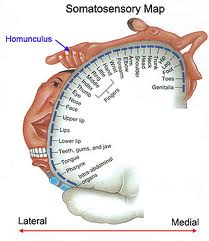In the last issue, I talked about body awareness, which includes receptors for pain. I began to think more about this and felt that pain deserved its’ own issue! So, this issue is dedicated to “nociceptors”! 
Brainwaves is a monthly newsletter designed to create some “brainwaves” within my community of colleagues, friends and clients.
For some children, eating is painful…or so it seems. They will only eat certain foods, often based upon texture which is actually our sense of touch. Other children react emotionally to being lightly touched, accusing others of hurting them. I have met a young woman who found the color yellow painful to look at and the high frequency of her mother’s voice almost intolerable. Thinking about these children, consider this definition of chronic pain from the Canadian Institute for the Relief of Pain and Disability:
“What is Chronic Pain?
Pain is defined as “an unpleasant sensory and emotional experience associated with actual or potential tissue damage, or described in terms of such damage” by the International Association for the Study of Pain (IASP).
Chronic pain can be an abnormal processing of pain where the original injury or cause of acute pain has resolved, but the warning system has failed to shut off. When this occurs the warning bells are still going off, however it is no longer signaling “danger” or “harm” but rather indicating a problem of pain processing.
There are different types of chronic pain:
- Musculoskeletal Pain – Pain that affects the bones, muscles, ligaments and tendons. Musculoskeletal pain can result from various causes including sports or occupational injuries, motor vehicle collisions, repetitive strain injuries and disease processes, such as, arthritis.
- Neuropathic Pain – A complex, multi-faceted state of chronic pain that may have no obvious cause. It can involve damaged tissue, injury or malfunctioning nerve fibers or changes in brain processing…Other types of neuropathic pain include numbness, burning, “pins and needles” sensations and shooting pain.”
So, these are the words that I picked out that seem to match the children with sensitivities that I am thinking about… with varying intensity, known or unknown cause, warning system has failed to turn off, changes in brain processing and neuropathic pain.”
has failed to turn off, changes in brain processing and neuropathic pain.”
Recently I have been participating in the National Institute for the Clinical Application of Behavioral Medicine brain series webinars. It has been a fascinating series of one hour interviews with notable brain researchers such as Norman Doidge, author of “The Brain that Changes Itself”. In his book, he describes chronic pain in terms of a chronic triggering of a nerve pathway. Now, each pathway extends into our brain where into our sensory map. This is known as the homunculus. According to Doidge, repeated triggering of an area results in a bigger “pain” brain map. The more the person thinks about the pain and the fear, the bigger the map becomes.
What can be done?
This is the million dollar question of course but what I keep hearing over and over again is the need to generally create a calmer body system;
- exercise that increases the heart rate; sufficient amounts of sleep;
- the need to shift the focus away from the pain (distraction)
- the need to engage our social brain through enjoyable, calming relationships that mirror the acceptance of the moment (even if you are still trying to find a solution)
An interesting idea in Doidge’s book (chapter 7) includes fooling the brain. My personal “take” on this strategy is to expose the brain to pleasant or typical images of the situation that is generally unpleasant or difficult.
- For a child who has difficulties eating, this might mean taking pictures or creating a movie showing the child in moments of enjoyment and laughter during feeding.
- For a with touch sensitivity, it might mean viewing pictures or movies of themselves enjoying the company of someone who is touching them. It is known that our sensory thresholds can be changed by exposure to these sorts of situations.
What do you think about these ideas?
Workshops
Understanding Behavior from a Sensation Point of View, April 19, 2013
Dauphin, Manitoba, email [email protected] for more information
Interesting Video
Norman Doidge http://www.cbc.ca/player/Shows/ID/2332409695/
